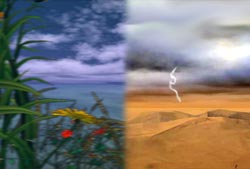
Methane gas bubbles up from Siberian lakes at up to six times the rate previously thought as a result of global warming, a new study suggests. The result: more global warming.
One consequence: Carbon in the permafrost is released into the atmosphere. Another is that thawing permafrost along the margins of a lake dislodges frozen plant and animal remains, causing them to sink to the bottom of the lakes, where they decompose and produce methane, a potent greenhouse gas.
Some of the methane diffuses through the lake water and into the air, but the majority of it escapes by bubbling to the surface. Until now, this bubbling, or "ebullition," process has been hard to measure because of the difficulty involved in determining where and when the bubbles will occur.
In the new study, researchers used a combination of aerial surveys, remote sensors and year-round measurements of places in two Siberian lakes where methane bubbling was known to occur. To identify bubble hot spots, they surveyed the lakes in autumn, when bubbles rising to the surface freeze in place, leaving behind visible trails.
The cycle works like this: Thawing permafrost dumps tons of previously frozen organic material into lake bottoms, producing methane. The methane finds its way into the atmosphere, where it works with other greenhouse gases to trap the sun's rays. The planet warms even more, causing permafrost to thaw at a quicker pace.
Other Global Warming Effects
- Seas Rise
- More Wildfires
- Deserts to Grow
- Greenland Melts
- Mountains Grow
- Ground Collapses
- Glaciers Disappear
- Allergies Get Worse
- Summer Gets Longer
- Animal DNA Changing
- Animals Change Behavior
- Rivers Melt Sooner in Spring
- Increased Plant Production
- Hurricanes Get Stronger
- Some Trees Benefit
- Lakes Disappear
Hot Topic
Get the world’s most fascinating discoveries delivered straight to your inbox.
What makes Earth habitable? This LiveScience original video explores the science of global warming and explains how, for now, conditions here are just right.
- Global Warming or Just Hot Air? A Dozen Different Views
- Global Warming Differences Resolved
- Conflicting Claims on Global Warming and Why It's All Moot
- Baffled Scientists Say Less Sunlight Reaching Earth
- Scientists Clueless over Sun's Effect on Earth
- Greenhouse Gas Hits Record High
- Key Argument for Global Warming Critics Evaporates
- All About Global Warming
 Live Science Plus
Live Science Plus






